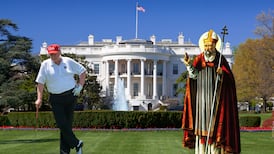THE Ireland of 150 years ago was, not unlike today, a fertile field for visiting job recruiters. Unfortunately, one of the big overseas employment areas then was the American civil war. And to the numerous Irishmen always willing to volunteer for foreign conflicts were added many emigrants who ended up in uniform – the Union blue, usually – by deception.
At the height of the war, in the summer of 1863, the Confederate government was sufficiently concerned about the press-ganging of Irishmen that it despatched secret agents to counter the Union’s recruitment (which was also furtive, the Fenian-obsessed British government being understandably hostile to the idea of Irishmen acquiring US military experience).
Reassigning an officer to the mission, the Confederate Secretary of State, JP Benjamin, ordered that he should shadow these agents “who leave untried no method of deceiving the laboring population into emigrating for the ostensible purpose of seeking employment in the United States, but really for recruiting [to] the Federal armies”.
The officer was to use “strictly legitimate, honorable, and proper” means, he said, mainly counter-persuasion. An important argument, Benjamin suggested, would be to remind potential recruits they might end up fighting “their own friends, and perhaps kinsmen, in a quarrel which does not concern them.” In particular, he advised the agent: “Relate to them the story of Meagher’s Brigade, its formation and its fate.” That last bit referred to events of the previous December, when the former Young Irelander, Thomas Francis Meagher, led his already-storied regiment – the “Fighting 69th” – in a doomed assault at the Battle of Fredericksburg, charging uphill against impregnable rebel defences, also manned by Irishmen.
Less than a quarter of the 1,200-strong force survived what Confederate General Robert E Lee called their “brilliant but hopeless” attack. And a poignant footnote to that heroic disaster was that Meagher’s men had been due to receive new regimental colours to replace the ones shot to ribbons in previous engage’ments. By the time the replacements arrived, the regiment itself had been all but obliterated.
A century later, seeking a suitably impressive gift for his ancestral homeland, John F Kennedy needed look no further than the still-pristine replacement colours of the 69th. He presented them to Ireland on the occasion of his address to the Oireachtas: spoiling the moment only slightly by repeating his scriptwriter’s incorrect date for the Battle of Fredericksburg. The colours remain in Leinster House today, their emotive power even greater because of the president’s own fate.
THERE are many Irish stories entangled in the history of the USA’s greatest conflict and most of them are on a superb website called irishamericancivilwar.com, created by Cork-based archaeologist Damien Shiels. Not all the stories are heroic, although the site does include an archive of no fewer than 32 Irish-born soldiers who became “breveted” generals (“breveting” being an honorary promotion, usually without the pay increase) on the Union side alone.
There are quirkier tales too, like that of the soldier who fought under the name of Albert Cashier. A private – in more ways than one – he later proved to have been a woman, born Jennie Hodgers in Clogherhead, Co Louth. Despite, or perhaps because of, a diminutive physique, Albert/Jennie had survived the war and it was only when she was in a soldiers’ retirement home, 50 years later, that her secret finally became public.
A reporter from the Hartford Republicandescribed interviewing her then: "I had expected to meet an amazon. A woman who had fought in the death grapple of a nation and had lived and toiled as a man through half a century should be big, strong and masculine. [But] when I entered her hospital ward there rose and came to meet me, in her faded soldier's uniform, just a little frail, sweet-faced, old-lady, who might be anybody's grandmother."
Speaking of uniforms, another story is that many of the Confederates’ grey costumes were also made in Ireland: Limerick to be exact, at Tait’s factory, which still stands, although derelict. Still standing too is a huge cotton mill in Portlaw, Co Waterford that became inextricably associated with the Confederacy’s cause. At its height, it employed 1,500 people. But when the south fell, so did the milling business.
What all these stories have in common, a century and a half later, is that they are of potential interest to the many Americans who have made a pastime of studying civil war history and visiting the various sites. It’s a billion dollar industry in the US. But Britain has been cottoning on of late to the possibility of tempting this niche market across the Atlantic.
And now a group of Irish enthusiasts, including Shiels and Waterford man James Doherty, think it’s time this country did too. They have two primary aims: to erect a monument somewhere to the 200,000 Irish people who were involved in the war, on one side or other; and to link the more than 40 sites of interest already identified around Ireland into a heritage trail.
As Doherty points out, those most fascinated by the subject tend to be retired military officers or other professionals with disposable income on their hands. If Ireland attracted even one tour a week during the summer season, it would be a worthwhile. And with the various sesquicentenaries already rolling, there’s no time to waste.
There might be a certain historic justice in the work too. Anyone interested in becoming an undercover recruiting agent, or otherwise helping the cause, should contact James and his fellow volunteers via americancivilwarandireland@gmail.com









